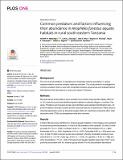| dc.description.abstract | Background
The role of larval predators in regulating the Anopheles funestus population in various
malaria-endemic countries remains relatively unknown. This study aimed to investigate the
common predators that co-exist with Anopheles funestus group larvae and evaluate factors
that influence their abundance in rural south-eastern Tanzania.
Methods
Mosquito larvae and predators were sampled concurrently using standard dipper (350 ml)
or 10 L bucket in previously identified aquatic habitats in selected villages in southern Tan zania. Predators and mosquito larvae were identified using standard identification keys. All
positive habitats were geo-located and their physical features characterized. Water physico chemical parameters such as dissolved oxygen (DO), pH, electrical conductivity (EC), total
dissolved solids (TDS) and temperature were also recorded.
Results
A total of 85 previously identified An. funestus aquatic habitats in nine villages were sampled
for larvae and potential predators. A total of 8,295 predators were sampled. Of these Coena grionidae 57.7% (n = 4785), Corixidae 12.8% (n = 1,060), Notonectidae 9.9% (n = 822),
Aeshnidae 4.9% (n = 405), Amphibian 4.5% (n = 370), Dytiscidae 3.8% (n = 313) were com mon. A total of 5,260 mosquito larvae were sampled, whereby Anopheles funestus group
were 60.3% (n = 3,170), Culex spp. 24.3% (n = 1,279), An. gambie s.l. 8.3% (n = 438) and
other anophelines 7.1% (n = 373). Permanent and aquatic habitats larger than 100m2 were
positively associated with An. funestus group larvae (P<0.05) and predator abundance(P<0.05). Habitats with submerged vegetation were negatively associated with An. funestus
group larvae (P<0.05). Only dissolved oxygen (DO) was positively and significantly affect
the abundance of An. funestus group larvae (P<0.05). While predators’ abundance was not
impacted by all physicochemical parameters.
Conclusion
Six potential predator families were common in aquatic habitats of An. funestus group lar vae. Additional studies are needed to demonstrate the efficacy of different predators on lar val density and adult fitness traits. Interventions leveraging the interaction between
mosquitoes and predators can be established to disrupt the transmission potential and sur vival of the An. funestus mosquitoes | en_US |

